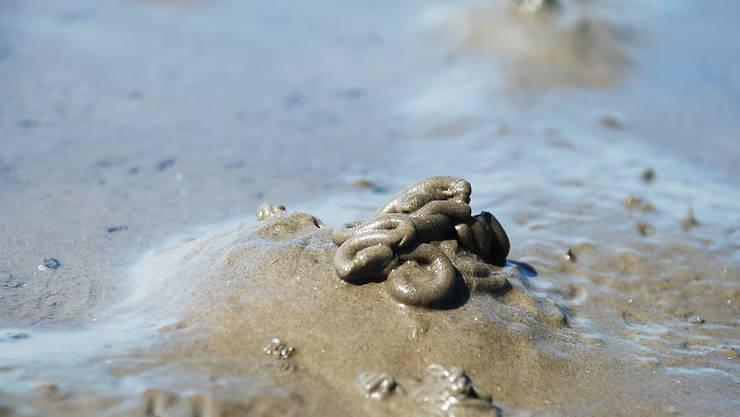The Fascinating World of the Lugworm
The lugworm, scientifically known as Arenicola marina, is a remarkable marine creature that quietly shapes tidal flats and supports coastal ecosystems. Though often overlooked, these worms act as nature’s engineers, creating burrows and casts that influence sediment structure, oxygen flow, and biodiversity.
The Hidden Life of Lugworms
Lugworms spend most of their lives beneath the sand, digging U-shaped burrows that serve as both shelter and a respiratory system. Through constant burrowing and feeding, they generate unidirectional water currents, enhancing oxygen exchange in their gills and aerating the seabed for countless other organisms.
Shaping Sandy Tidal Flats
These small but mighty creatures are central to the health of tidal flats. By feeding on organic matter in the sand and excreting cleaned grains, lugworms:
- Aerate and enrich the sediment, supporting marine biodiversity
- Stabilize sandy environments and reduce erosion
- Create distinctive casts and patterns on the beach surface
Together, their activities maintain balance in coastal ecosystems, turning the shoreline into a living, shifting mosaic.
The European Lugworm: A Coastal Engineer
The European lugworm plays a vital role in structuring sandy shores. Its intricate burrows improve soil quality, while its distinctive heaps of sand—known as casts—signal its hidden presence. These casts not only demonstrate the worm’s activity but also reflect a dynamic cycle of feeding, filtering, and replenishing the habitat.
Lugworms and the Wadden Sea
The Wadden Sea, a UNESCO World Heritage site, is one of the most important habitats for lugworms. Their burrowing activities sustain the mudflats, while their casts provide vital microhabitats. Anglers also dig lugworms for fishing bait, adding a human connection to their ecological significance.
Lugworm Casts: Nature’s Sand Art
One of the most visible signs of lugworm activity is the coiled heaps of sand they leave behind. These casts are more than beach curiosities:
- They reveal the worm’s underground feeding behavior
- They contribute to sediment oxygenation and nutrient cycling
- They reflect the health and quality of the coastal environment
Each cast is a small but vital reminder of the lugworm’s ecological role.
Global Distribution and Ecosystem Impact
Lugworms are found across European coasts, from Germany’s Wadden Sea to Norway and France. No matter the region, their impact is the same: stabilizing sands, supporting marine food webs, and influencing the overall structure of the ecosystem.
Why Lugworms Matter
By recycling nutrients and aerating sediments, lugworms enhance the productivity of tidal flats. Their presence ensures that bacteria, invertebrates, fish, and birds thrive in interconnected coastal environments. They are a foundation species, quietly sustaining balance beneath the surface.
Conclusion
Though often hidden beneath the sand, lugworms are essential to the vitality of coastal regions. From their U-shaped burrows to their sand art-like casts, they exemplify the intricate connections that sustain marine ecosystems. Protecting these humble creatures means safeguarding the delicate balance of our coastal habitats.

